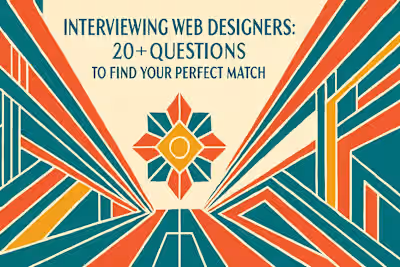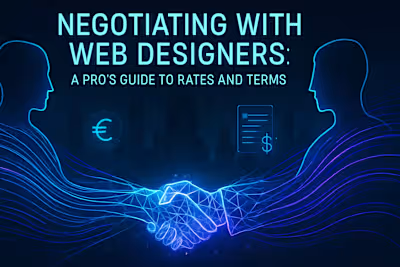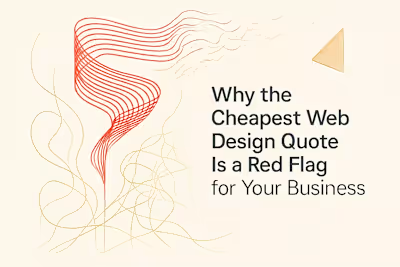Comparing Web Design Proposals: How to Evaluate Quotes and SOWs

Comparing Web Design Proposals: How to Evaluate Quotes and SOWs
Beyond the Bottom Line: What to Look for in a Proposal
Detailed Scope of Work (SOW)
Project Timeline and Milestones
The Team and Their Process
Portfolio and Case Studies
Comparing Apples to Apples: How to Score a Fair Comparison
Create a Comparison Matrix
Evaluate the 'Value' Not Just the 'Cost'
Assess Understanding of Your Goals
Red Flags to Watch Out For in a Web Design Quote
The Price is Too Good to Be True
Vague or Missing Details
Unrealistic Promises
Poor Communication
References
Comparing Web Design Proposals: How to Evaluate Quotes and SOWs
After interviewing your top candidates, you'll likely have several proposals to review. Comparing them effectively is about more than just finding the lowest price; it's about identifying the best value and the right partner for your project. This article will guide you through evaluating web design quotes and Scopes of Work (SOWs) to make an informed decision.
This follows the crucial step of interviewing web designers. Once you've chosen a proposal, the next stage is often negotiating rates and terms. When you're ready to move forward, you can hire web designers who match your specific needs and budget.
Beyond the Bottom Line: What to Look for in a Proposal
A good proposal is a roadmap for your project. Think of it as your first glimpse into how a designer works and thinks. While price matters, it's just one piece of the puzzle. The best proposals tell a story about how your website will come to life.
I've reviewed hundreds of proposals over the years, and the ones that lead to successful projects share common traits. They're detailed without being overwhelming. They show genuine understanding of your business. Most importantly, they give you confidence that the designer can deliver what you need.
Detailed Scope of Work (SOW)
The SOW should be comprehensive, clearly outlining all deliverables, features, and the number of pages. A vague scope is a major red flag. When I see phrases like "website design" without specifics, I know trouble's ahead.
A solid SOW breaks down exactly what you're getting. It lists every page, every feature, and every deliverable. For example, instead of "homepage design," it should say "homepage with hero section, three feature blocks, testimonial carousel, and newsletter signup." This level of detail protects both you and the designer.
Look for specifics about responsive design, browser compatibility, and any custom functionality. If you need a contact form, does the SOW specify form fields, validation, and where submissions go? These details matter when the project gets rolling.
Project Timeline and Milestones
A professional proposal will include a clear timeline with key milestones, showing a structured approach to project management. Real designers know that websites don't happen overnight. They plan each phase carefully.
Good timelines break the project into digestible chunks. You might see phases like "Discovery and Planning" (1-2 weeks), "Design Concepts" (2-3 weeks), "Development" (3-4 weeks), and "Testing and Launch" (1 week). Each phase should have clear deliverables and review points.
Watch out for timelines that seem rushed or vague. "Website complete in 2 weeks" usually means corners will be cut. On the flip side, a six-month timeline for a five-page site might indicate the designer is overbooked or inefficient.
The Team and Their Process
Does the proposal explain who will be working on your project and what their design and development process looks like? Transparency here is a good sign. You want to know if you're hiring a solo designer or a team, and who handles what.
Strong proposals introduce the team members and their roles. Maybe Sarah handles design, while Mike codes the site. Perhaps they bring in Emma for copywriting. Knowing who does what helps you understand their capacity and expertise.
The process description should feel logical and tested. Look for mentions of discovery sessions, mood boards, wireframes, and revision rounds. A designer who can clearly explain their process has likely refined it through experience. Vague descriptions like "we'll make your site awesome" don't inspire confidence.
Portfolio and Case Studies
The proposal should link to relevant work that demonstrates their ability to deliver what you need. Look for live websites, not just mockups. Pretty pictures are nice, but functioning websites prove real capability.
Pay attention to projects similar to yours. If you run a restaurant, have they designed restaurant sites before? The work should show range but also relevance. Click through the sites they've built. Do they load quickly? Work well on mobile? Function smoothly?
Case studies add another layer of insight. They show not just what the designer created, but how they solved problems. A good case study explains the client's challenges, the designer's approach, and the results achieved. Numbers help too – did the new site increase conversions or reduce bounce rates?
Comparing Apples to Apples: How to Score a Fair Comparison
To evaluate proposals objectively, you need a consistent framework. This section provides a method for a fair and balanced comparison. Without structure, it's easy to get swayed by flashy presentations or smooth talkers.
I learned this lesson the hard way early in my career. I chose a designer based on gut feeling and a slick proposal. The project turned into a nightmare. Now I use a systematic approach that removes emotion from the equation.
Create a Comparison Matrix
Use a spreadsheet to list your key criteria (e.g., price, timeline, features, experience) and score each proposal against them. This helps remove personal bias. Start by listing what matters most to your project.
Your criteria might include total cost, payment terms, timeline, included features, revision rounds, post-launch support, and relevant experience. Assign weights to each criterion based on importance. Maybe timeline is crucial because you have a product launch, so it gets 25% weight. Price might be 20%, features 30%, and so on.
Score each proposal on a scale of 1-10 for each criterion. Multiply by the weight and add up the totals. This gives you an objective ranking. Sometimes the results surprise you – the proposal you liked least emotionally might score highest objectively.
Evaluate the 'Value' Not Just the 'Cost'
The cheapest option is rarely the best. Consider what's included in the price. Does one proposal include services like SEO setup, content migration, or training that others charge for separately? These extras can save you thousands down the road.
I once had two proposals for the same project. One was $5,000, the other $7,500. The cheaper one seemed like a no-brainer until I dug deeper. The pricier option included a year of hosting, monthly maintenance, SEO optimization, and content management training. The "cheap" option charged extra for all of these. In the end, it would have cost $9,000 for the same services.
Look at post-launch support too. Some designers disappear after launch, while others offer ongoing help. Factor in the cost of future updates and changes. A slightly higher upfront cost might save you money long-term if updates are included or discounted.
Assess Understanding of Your Goals
Does the proposal reflect a deep understanding of your business and project goals? A generic, copy-paste proposal is a sign they haven't done their homework. The best proposals feel custom-written for your specific needs.
Look for references to your industry, target audience, and unique challenges. If you mentioned wanting to appeal to millennials, does the proposal address modern design trends? If you need e-commerce, do they discuss payment gateways and inventory management?
Personal touches matter too. Did they visit your current site and offer specific improvements? Do they reference your competitors and explain how they'll help you stand out? These details show they've invested time in understanding your project before quoting a price.
Red Flags to Watch Out For in a Web Design Quote
Some proposals might look good on the surface but hide potential problems. This section highlights common red flags to be aware of. Trust your instincts, but also know what specific warning signs to watch for.
After years in this industry, I've seen every trick in the book. Some designers prey on clients who don't know better. Others simply lack the experience to deliver quality work. Either way, these red flags can save you from costly mistakes.
The Price is Too Good to Be True
Extremely low prices often mean a templated, cookie-cutter approach or that the designer is inexperienced. This can lead to a poor-quality site that needs to be rebuilt later. Quality web design takes time and skill, both of which cost money.
If most quotes come in around $5,000 but one offers to do it for $500, ask yourself why. Are they using a basic template with minimal customization? Are they outsourcing to the lowest bidder? Are they desperate for work because their portfolio is weak?
I've seen businesses waste months and thousands of dollars on cheap websites that never worked properly. They end up hiring a professional anyway, essentially paying twice. Remember, your website is often the first impression customers have of your business. Don't let a bargain price tempt you into a bad decision.
Vague or Missing Details
A lack of detail on the scope, timeline, or process is a major warning sign. It often leads to scope creep and unexpected costs down the line. Vague proposals leave too much room for interpretation and conflict.
Watch for phrases like "standard website features" or "typical turnaround time." What's standard to them might not match your expectations. If the proposal doesn't specify the number of design concepts, revision rounds, or included pages, you're setting yourself up for arguments later.
Missing information about technical specifications is another concern. Will the site be mobile-responsive? Which browsers will it support? What about page load speeds? Professional designers address these details upfront because they know their importance.
Unrealistic Promises
Be wary of designers who guarantee #1 search engine rankings or instant results. Reputable professionals know that real results take time and strategy. Anyone promising overnight success either doesn't understand web design or isn't being honest.
SEO rankings depend on many factors beyond design. Content quality, competition, domain authority, and Google's ever-changing algorithms all play roles. A good designer can build an SEO-friendly site, but they can't guarantee rankings.
Similarly, be skeptical of promises about conversion rates or sales increases. While good design certainly helps, it's just one piece of your business success. Designers who overpromise often underdeliver, leaving you disappointed and out of pocket.
Poor Communication
If communication is slow or unclear during the proposal stage, it's unlikely to improve once the project starts. How quickly do they respond to emails? Are their answers clear and complete? Do they ask good questions about your project?
I once worked with a designer who took days to answer simple questions during the proposal phase. I ignored this red flag because their portfolio was impressive. The project dragged on for months with constant communication delays. Every revision request disappeared into a black hole for a week.
Good designers communicate proactively. They set expectations about response times and stick to them. They ask clarifying questions instead of making assumptions. They explain technical concepts in plain English. If you're struggling to get straight answers before they have your money, imagine how frustrating it'll be afterward.
Comparing web design proposals takes time and attention to detail. But this investment pays off when you find the right partner for your project. Use these guidelines to evaluate each proposal objectively. Look beyond the price to understand the true value offered.
Remember, you're not just buying a website. You're investing in a relationship with someone who'll help shape your online presence. Choose wisely, and your website will serve your business well for years to come. Rush the decision, and you might find yourself back at square one sooner than you'd like.
Take your time, ask questions, and trust your instincts. The right designer will make the process smooth and enjoyable. Their proposal will give you confidence, not confusion. When you find that match, you'll know you're ready to move forward with your web design project.
References
Like this project
Posted Jun 30, 2025
Struggling to compare web design quotes? This guide helps you evaluate proposals and scopes of work fairly, look for red flags, and choose the right designer for your budget.











